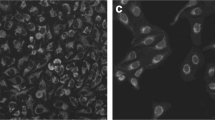Abstract
This paper concentrates on the use of Echo State Networks (ESNs), an effective form of reservoir computing, to improve microscopic cellular image segmentation. An ESN is a sparsely connected recurrent neural network in which most of the weights are fixed a priori to randomly chosen values. The only trainable weights are those of links connected to the outputs. The process of segmentation is conducted via two approaches: the basic form, which uses one reservoir, and our approach, which corresponds to using multiple reservoirs. Experimental results confirm the benefits of the second approach, which outperforms all state-of-the-art methods considered in this paper for the problem of microscopic image segmentation.








Similar content being viewed by others
References
Meijering E. Cell segmentation: 50 years down the road. Signal Process Mag IEEE. 2012;29(5):140. doi:10.1109/MSP.2012.2204190.
Khalbuss WE, Pantanowitz L, Parwani AV. Digital imaging in cytopathology. Pathology Res Int. 2011; 264683
Wu P, Yi J, Zhao G, Huang Z, Qiu B, Gao D. Active contour-based cell segmentation during freezing and its application in cryopreservation. Trans IEEE Biomed Eng. 2015;62(1):284.
Zeng Z, Strange H, Han C, Zwiggelaar R. In: Image analysis and recognition—10th international conference, ICIAR 2013, Póvoa do Varzim, Portugal, June 26–28, 2013. Proceedings 2013; p. 605–612
Su CYCM-C, Wang PC. A neural-network-based approach to white blood cell classification. Sci World J. 2014; 796371
Meftah B, Lézoray O, Chaturvedi S, Khurshid A, Benyettou A. Artificial intelligence, evolutionary computing and metaheuristics, studies. In: Yang XS, editor. Computational intelligence, vol. 427. Berlin: Springer; 2013. p. 525–44.
Chourasiya S, Rani G. Automatic red blood cell counting using watershed segmentation. Int J Comput Sci Inf Technol. 2014;5(4):4834.
Takemoto S, Yoshizawa S, Tsujimura Y, Yokota H. In: Computing and networking (CANDAR), 2013 first international symposium on 2013; p. 294–299
Lukoševičius M, Jaeger H. Reservoir computing approaches to recurrent neural network training. Comput Sci Rev. 2009;3(3):1574.
Strauß T, Wustlich W, Labahn R. Design strategies for weight matrices of echo state networks. Neural Comput. 2012;24(12):3246.
Koprinkova-Hristova P, Alexiev K. In: Artificial neural networks and machine learning - ICANN 2013. Lecture notes in computer science, vol. 8131. Berlin: Springer; 2013.
Woodward A, Ikegami T. In: 26th international conferences on image and vision computing 2011; p. 543–548
Koprinkova-Hristova P, Angelova D, Borisova D, Jelev G. In: Innovations in intelligent systems and applications (INISTA), 2013 IEEE international symposium on 2013; p. 1–5
Suganthi D, Purushothaman S. FMRI segmentation using echo state neural network. Int J Image Process. 2008;2(1):1.
Kainz P, Mayrhofer-Reinhartshuber M, Burgsteiner H, Asslaber M, Ahammer H. In: 48th annual conference of the German society for biomedical engineering; 2014
Malik Z, Hussain A, Wu J. Novel biologically inspired approaches to extracting online information from temporal data. Cogn Comput. 2014;6(3):595.
Mitul A, Rabin M, Rakeeb M, Khan AAM, Rana G, Mollah A, Rahman M. In: Informatics, electronics vision (ICIEV), 2013 international conference on 2013; p. 1–6
Bishop C. Pattern recognition and machine learning. Information science and statistics (Springer, 2007)
Cai Q., He H., Man H. In: The 2011 international joint conference on neural networks, IJCNN 2011, San Jose, California, USA, 2011; p. 2313–2320
Goudarzi A, Banda P, Lakin M, Teuscher C, Stefanovic D. CoRR abs/1401.2224 (2014)
Yildiz I, Jaeger H, Kiebel S. Re-visiting the echo state property. Neural Netw. 2012;35:1.
Lovlid R. A novel method for training an echo state network with feedback-error learning. Adv Artif Intell. 2013;2013(2514027):9:9.
Goudarzi A, Stefanovic D. Towards a calculus of echo state networks. Procedia Comput Sci. 2014;41:176.
Jaeger H. A tutorial on training recurrent neural networks, covering bppt, rtrl, ekf and the echo state network approach. Technical Report 159, German National Research Center for Information Technology (2002)
Meurie C, Lezoray O, Charrier C, Elmoataz A. Combination of multiple pixel classifiers for microscopic image segmentation. Int J Robot Autom. 2005;20(2):63.
Fuchs T, Buhmann J. Computational pathology: challenges and promises for tissue analysis. Comput Med Imaging Graph. 2011;35(7–8):515.
Dumont M, Marée R, Wehenkel L, Geurts P. In VISAPP 2009—proceedings of the fourth international conference on computer vision theory and applications, Lisboa, Portugal, February 5–8, 2009—vol 2, 2009; p. 196–203
Song Y, Cai W, Feng D. In: Digital image computing techniques and applications (DICTA), 2012 international conference on 2012; p. 1–6
Huang GB. An insight into extreme learning machines: random neurons, random features and kernels. Cogn Comput. 2014;6(3):376.
Lezoray O, Cardot H. Cooperation of color pixel classification schemes and color watershed: a study for microscopic images. IEEE Trans Image Process. 2002;11(7):783.
Jaeger H. In: Neural networks, 2005. IJCNN ’05. Proceedings. 2005 IEEE international joint conference on, 2005; vol 3, p. 1460–1462
Alexandre L, Embrechts M. In: Artificial neural networks—ICANN 2009, lecture notes in computer science, vol. 5768. Berlin: Springer; 2009. p. 1015–1024
Yuanbiao W, Ni J, Zhiping X. In: Internet computing for science and engineering (ICICSE), 2009 fourth international conference on 2009; p. 102–108
Venayagamoorthy GK, Shishir B. Effects of spectral radius and settling time in the performance of echo state networks. Neural Networks. 2009;22(7):861.
Koryakin D, Butz M. In: Artificial neural networks and machine learning—ICANN 2012, lecture notes in computer science, vol. 7552. Berlin: Springer; 2012. p. 499–506.
Rodan A, Tino P. Minimum complexity echo state network. Neural Netw IEEE Trans. 2011;22(1):131.
Triefenbach F, Jalalvand A, Schrauwen B, Martens JP. In: Advances in neural information processing systems, 2010; vol. 23, p. 9
Author information
Authors and Affiliations
Corresponding author
Rights and permissions
About this article
Cite this article
Meftah, B., Lézoray, O. & Benyettou, A. Novel Approach Using Echo State Networks for Microscopic Cellular Image Segmentation. Cogn Comput 8, 237–245 (2016). https://doi.org/10.1007/s12559-015-9354-8
Received:
Accepted:
Published:
Issue Date:
DOI: https://doi.org/10.1007/s12559-015-9354-8




